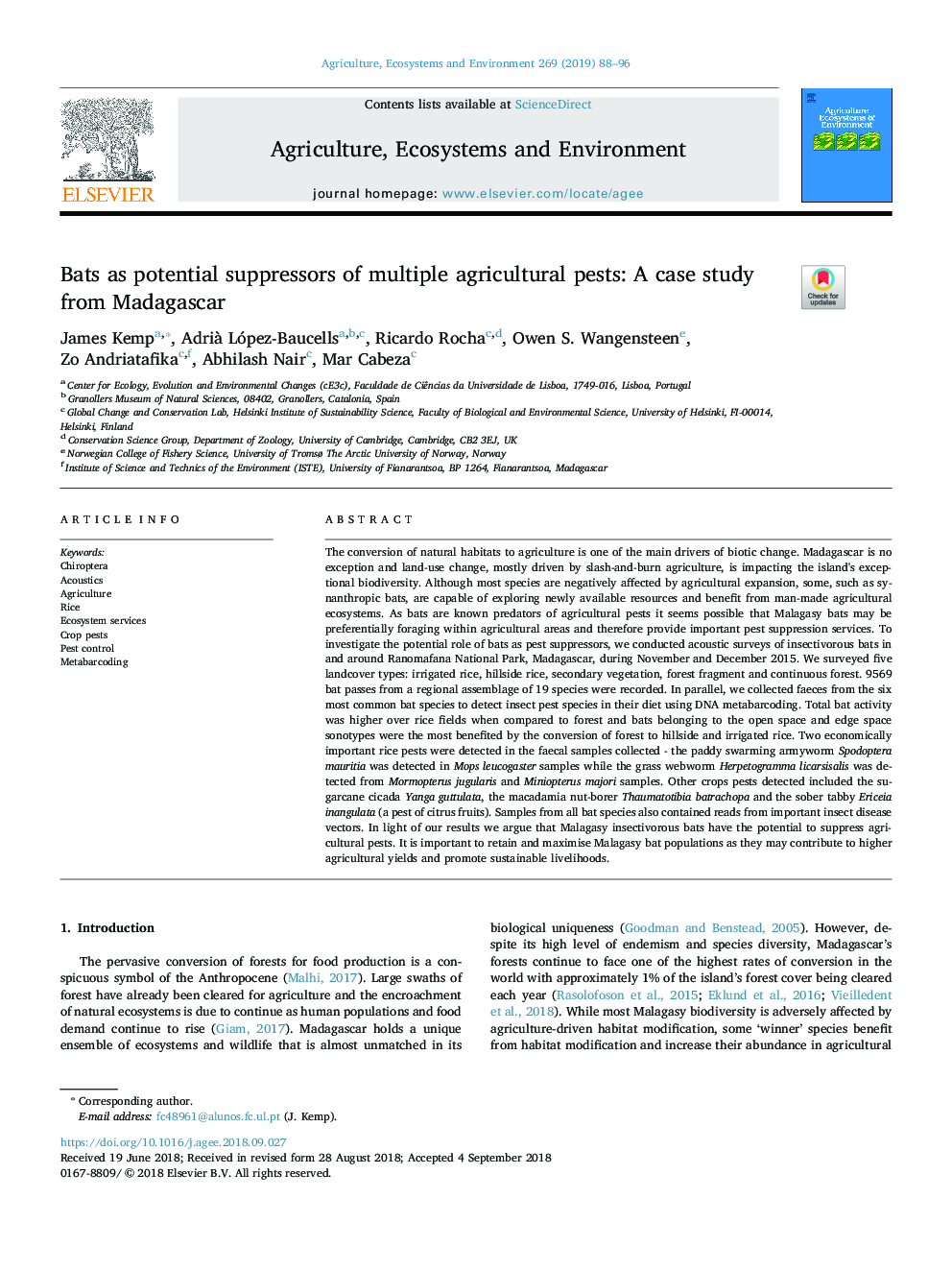| کد مقاله | کد نشریه | سال انتشار | مقاله انگلیسی | نسخه تمام متن |
|---|---|---|---|---|
| 10970597 | 1104192 | 2019 | 9 صفحه PDF | دانلود رایگان |
عنوان انگلیسی مقاله ISI
Bats as potential suppressors of multiple agricultural pests: A case study from Madagascar
ترجمه فارسی عنوان
خفاش ها به عنوان سرکوبگرهای بالقوه بسیاری از آفات متعدد کشاورزی: مطالعه موردی از ماداگاسکار
دانلود مقاله + سفارش ترجمه
دانلود مقاله ISI انگلیسی
رایگان برای ایرانیان
کلمات کلیدی
موضوعات مرتبط
علوم زیستی و بیوفناوری
علوم کشاورزی و بیولوژیک
علوم زراعت و اصلاح نباتات
چکیده انگلیسی
The conversion of natural habitats to agriculture is one of the main drivers of biotic change. Madagascar is no exception and land-use change, mostly driven by slash-and-burn agriculture, is impacting the island's exceptional biodiversity. Although most species are negatively affected by agricultural expansion, some, such as synanthropic bats, are capable of exploring newly available resources and benefit from man-made agricultural ecosystems. As bats are known predators of agricultural pests it seems possible that Malagasy bats may be preferentially foraging within agricultural areas and therefore provide important pest suppression services. To investigate the potential role of bats as pest suppressors, we conducted acoustic surveys of insectivorous bats in and around Ranomafana National Park, Madagascar, during November and December 2015. We surveyed five landcover types: irrigated rice, hillside rice, secondary vegetation, forest fragment and continuous forest. 9569 bat passes from a regional assemblage of 19 species were recorded. In parallel, we collected faeces from the six most common bat species to detect insect pest species in their diet using DNA metabarcoding. Total bat activity was higher over rice fields when compared to forest and bats belonging to the open space and edge space sonotypes were the most benefited by the conversion of forest to hillside and irrigated rice. Two economically important rice pests were detected in the faecal samples collected - the paddy swarming armyworm Spodoptera mauritia was detected in Mops leucogaster samples while the grass webworm Herpetogramma licarsisalis was detected from Mormopterus jugularis and Miniopterus majori samples. Other crops pests detected included the sugarcane cicada Yanga guttulata, the macadamia nut-borer Thaumatotibia batrachopa and the sober tabby Ericeia inangulata (a pest of citrus fruits). Samples from all bat species also contained reads from important insect disease vectors. In light of our results we argue that Malagasy insectivorous bats have the potential to suppress agricultural pests. It is important to retain and maximise Malagasy bat populations as they may contribute to higher agricultural yields and promote sustainable livelihoods.
ناشر
Database: Elsevier - ScienceDirect (ساینس دایرکت)
Journal: Agriculture, Ecosystems & Environment - Volume 269, 1 January 2019, Pages 88-96
Journal: Agriculture, Ecosystems & Environment - Volume 269, 1 January 2019, Pages 88-96
نویسندگان
James Kemp, Adrià López-Baucells, Ricardo Rocha, Owen S. Wangensteen, Zo Andriatafika, Abhilash Nair, Mar Cabeza,
